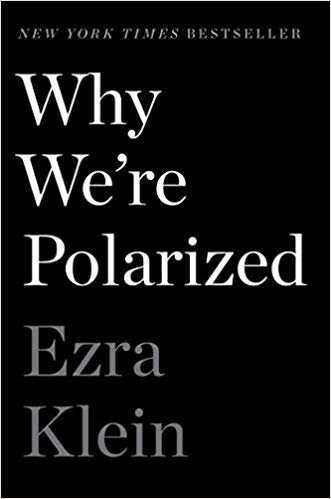Why We're Polarized by Ezra Klein
/
Why We’re Polarized
by Ezra Klein
Avid Reader Press, 2020
In 1994 a Pew Research survey found that 39 percent of Democrats and 26 percent of Republicans said racial discrimination was the main reason many black people could not get ahead. In 2017, 64 percent of Democrats (a 64.1 percent increase) and 14 percent of Republicans (a 46.15 percent decrease) agreed with the statement.
Between 1972 and 1984, the average difference between how a state voted in one presidential election verses the next was 7.7 percentage points. From 2002 to 2012, it was 1.9 percentage points. Additionally, in 1992, 39 percent of voters were living in landslide counties for presidential elections, and in 2016 that was up to 61 percent of voters.
Before Colin Kaepernick kneeled during the 49ers’ final preseason game and before GQ made him its citizen of the year, around 60 percent of both Trump and Clinton voters had a favorable view of the NFL. In the middle of the controversy the NFL’s favorability rating among Clinton supporters had not changed. Its favorability among Trump voters tumbled to 30 percent and disapproval jumped to above 60%.
These are just a few of many figures and studies Ezra Klein, editor-at-large and cofounder of Vox, cites and elaborates on in his book Why We’re Polarized to demonstrate that the Republican and Democratic parties are more contrary to one another than in the past. Now, to point out that politics is divisive is to utter a truism, and to claim we are more polarized than we were during the Civil War is absurd. His argument, however, isn’t that major issues today are more estranging than before, but that ideology and demography weren’t such strong indicators of party affiliation, and that these differences are becoming increasingly refined:
Democrat now means liberal and Republican now means conservative in a way that wasn’t true in, say, 1955. The rise in partisanship is, in part, a rational response to the rise in party difference – if the two sides hated and feared each other less fifty years ago, well, that makes sense; they were more similar fifty years ago
. . .Today the parties are sharply split across racial, religious, geographic, cultural, and psychological lines. There are many, many powerful identities lurking in that list, and they are using together, stacking atop one another, so a conflict or threat that activates one activates all. And since these mega-identities stretch across so many aspects of our society, they are constantly being activated, and that means they are constantly being reinforced.
The inflection point was the 1964 Civil Rights Act. Prior to that, and after the Civil War, “the restoration of what was, in effect, the Confederate political hierarchy in the South” yielded a grotesque settlement where authoritarianism and terrorism in the South was accommodated to avoid sabotaging the Democratic Party’s national program. But, as Klein notes, “The South was in the Democratic Party, but it didn’t agree with the Democratic Party,” and the net effect was that “Southern power kept the Democratic Party less liberal than it otherwise would’ve been, the Republican Party congressionally weaker than it otherwise would’ve been, and stopped the two parties from sorting themselves around the deepest political cleavage of the age.”
The Civil Rights Act passed with over four-fifths of Republicans and two-thirds of Democrats. Despite that unbalance, with the Democratic majority in the House and Senate, with the White House, and with their redistributionist policies, the Democrats became the party of civil rights (“So why are the Democrats seen as the party that passed the Civil Rights Act? There, the answer is simple. Because they were the party that passed the Civil Rights Act”). Klein, in agreement with Geoffrey Kabaservice, maintains that Goldwater’s opposition to that law prevented the Republican Party from assuming that position. Worse than that:
His disastrous presidential campaign succeeded in only one region of the country: the old Confederacy, which realized that the language of small government conservatism could be weaponized against the federal government’s efforts to right America’s racial wrongs.
To put it bitingly: minority, but not insignificant, portions of the US population have always been insane. Institutionally, the influence some of these groups had - like the Dixiecrats - was plainly evil and congressionally significant. That leverage resulted in a more transactional party politics and the racist exclusion of huge parts of the population; after the Civil Rights Act, and into our “era of profound, powerful social change,” the stacking of ideological and demographic identities has led to a less extreme but more polarized arrangement – and those with animosity toward that social change are noticeably grouped in one party.
Cantankerous factions have always been an important and even lovable part of America. That the Republican Party has been more affected by polarization (“if polarization has given the Democratic Party the flu, the Republican Party has caught pneumonia”), that it has been captured by less lovable minority factions (evidenced in part by enthusiastic support for the dumbest and most transparently bigoted president in modern history), and that polarization lead to gridlock, might be what explains Ezra Klein’s neglect of economic factors and his bias against the structure of some American institutions in favor of changes that would result in more proactive governance. His neglect of economic factors is a major weakness of the book. Incomplete or unpersuasive institutional arguments should be a weakness, but given that his views here are either objectionable and lack force, or just lack force, we have a weak chapter instead of a distracting chapter in an otherwise excellent book. Why We’re Polarized is already set up to be one of the most cutting and intelligent books on American politics this year.
—David Murphy holds a Masters of Finance from the University of Minnesota.
